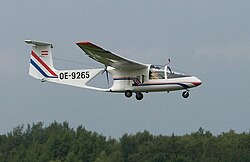Brditschka HB-3
| HB-3 | |
|---|---|

|
|
| Type: | Motor sailer |
| Design country: | |
| Manufacturer: | |
| First flight: |
1968 |
| Production time: |
1970–? |
| Number of pieces: |
8 (number of self-made buildings unknown) |
The HB-3 is a motor glider from the Austrian manufacturer HB Brditschka . It represents a further development of the Raab Krähe . With a modified version, the MB-E1 , the first flight of an electric airplane was carried out in 1973 .
history
As an amateur builder, Heinz W. Brditschka had already built two examples of the motorized crow in the 1960s and also manufactured aircraft parts for other amateur builders in the family's own jewelry business. From 1967 to 1969 the HB-3 was developed on this basis as a further development of the motorized crow. Heinz Brditschka provided the propulsion system, while Heino Brditschka, 17 years old at the time, provided the airframe . The first flight took place in 1968. In 1970, the newly created aircraft construction department started producing entire machines and individual parts for amateur construction. It was manufactured in the versions HB-3 BR and HB-3 AR , which differ among other things in terms of the maximum permissible weights and speeds. Brditschka produced four copies of both versions; the number of amateur builds is unknown.
The HB-3 later served Brditschka as the basis for the two-seater HB-21 .
MB-E1
The MB-E1 , built in 1973, is widely recognized as the world's first man-carrying electric aircraft . Fred Militky had been involved in the development of electrically powered flight models for over 18 years and was convinced that the technology had advanced enough that it could also be used in manned aircraft. Brditschka agreed to provide the prototype of the HB-3 for this purpose. They were equipped with an electric motor from Bosch , the power of which is given in the literature with values of 8 to 10 kW . Nickel-cadmium batteries from VARTA with a charge of 24 Ah were used as the energy source . Apart from the modified power transmission between the engine and propeller, these were the only changes compared to the production model.
The first flight of the MB-E1 marked OE 9023 took place on October 21, 1973 in Wels near Linz . There are contradicting information on the length of the flight, ranging from 9:05 min to 9:15 min up to 14 min. The fact is, however, that this flight received an entry in the Guinness Book of Records . Recognition as an FAI record was not possible for this flight at the time: first considerations for creating a competitive class for electric aircraft were only made towards the end of the 1990s.
construction
The construction of the HB-3 is based heavily on the Raab Krähe: A characteristic of this single-seat high- wing aircraft is the pusher propeller , which is attached to a fuselage section behind the wings. The wooden wing with fabric covering was taken over from the Krähe, but reinforced in the HB-3 BR version . The fuselage, on the other hand, was revised and the wooden structure of the crow replaced by a tubular steel frame with GRP cladding. The crow's landing gear, consisting of a central wheel with a tail spur, gave way to a spring-loaded tripod landing gear .
While the prototype still housed the Puch engine already used in the Krähe, a Rotax 642 with 29.4 kW (40 hp) was used in the production models .
Technical specifications
| Parameter | HB-3 BR | HB-3 AR |
|---|---|---|
| crew | 1 pilot | |
| Passengers | 0 | |
| Max. Takeoff mass | 380 kg | 420 kg |
| Maximum weight of the non-structural parts |
304 kg | 325 kg |
| Maximum speed (V NE ) | 175 km / h | 145 km / h |
| Maneuver speed (V M ) | 129 km / h | 124 km / h |
| Engine | Rotax 642 with 29.4 kW (40 PS) | |
| propeller | Hoffmann HO11-150B 100LD | |
Individual evidence
- ↑ a b c d e f Chronicle. In: hb-flugtechnik.at. HB-Flugtechnik , accessed on November 27, 2015 .
- ^ A b c d e RW Simpson: Airlife's General Aviation . A guide to Postwar General Aviation Manufacturers and their aircraft. 2nd Edition. Airlife Publishing, 1995, ISBN 1-85310-577-5 , pp. 87-88 .
- ↑ a b c d e Federal Office for Civil Aviation : Sample identification sheet SF 6/84 for the HB-3 BR and HB-3 AR series , edition 1, May 1984, published on June 20, 1984, austrocontrol.at (PDF), accessed on January 19, 2012.
- ↑ a b c d e f g Ron Moulton: An electric airplane . In: Flight International . tape 104 , no. 3378 . IPC Transport Press, London December 6, 1973, p. 946 ( flightglobal.com [PDF; accessed January 19, 2012]).
- ↑ a b c d e The Guinness Book of Records 1994 . Bantam, 1994, ISBN 978-0-553-56561-4 , pp. 328 .
- ^ A b Pierluigi Duranti, FAI : Electrical and Sun Powered Gliders: Do They Require a Definition of New FAI Classes? Presented at the XXV OSTIV Congress, St. Auban, France. In: Technical Soaring . tape XXII , no. 3 , 1998, ISSN 0744-8996 , p. 66-73 .
- ↑ Sports aviation . tape 23 , 1974, ISSN 0038-7835 , pp. 58 (English): “But the manned electric airplane MB-E1 rose from the runway without difficulty on the first attempt on October 21, 1973, reached an altitude of 1000 feet in climbing flight, flew several rounds over the airfield and landed safely after 9 minutes, 15 seconds of flight time. "